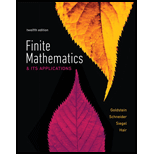
Three-Sector Economy In Exercises 1–12, suppose that a simplified economy consisting of the three sectors Manufacturing, Energy, and Services has the input–output matrix
Repeat Exercise 11 for the consumer demand matrix
Want to see the full answer?
Check out a sample textbook solution
Chapter 2 Solutions
MyLab Math plus Pearson eText -- Standalone Access Card -- for Finite Mathematics & Its Applications (12th Edition)
- Is the function f(x) shown in the graph below continuous at x = −5? f(x) 7 6 5 4 2 1 0 -10 -9 -8 -7 -6 -5 -4 -3 -2 -1 0 1 2 3 4 5 6 7 8 9 10 -1 -2 -3 -4 -5 -6 -7 Select the correct answer below: The function f(x) is continuous. ○ The right limit exists. Therefore, the function is continuous. The left limit exists. Therefore, the function is continuous. The function f(x) is discontinuous. ○ We cannot tell if the function is continuous or discontinuous.arrow_forward1.3. The dots of Output 2 lie in pairs. Why? What property of esin(x) gives rise to this behavior?arrow_forward1.6. By manipulating Taylor series, determine the constant C for an error expansion of (1.3) of the form wj−u' (xj) ~ Ch¼u (5) (x;), where u (5) denotes the fifth derivative. Based on this value of C and on the formula for u(5) (x) with u(x) = esin(x), determine the leading term in the expansion for w; - u'(x;) for u(x) = esin(x). (You will have to find maxε[-T,T] |u(5) (x)| numerically.) Modify Program 1 so that it plots the dashed line corresponding to this leading term rather than just N-4. This adjusted dashed line should fit the data almost perfectly. Plot the difference between the two on a log-log scale and verify that it shrinks at the rate O(h6).arrow_forward
- 4. Evaluate the following integrals. Show your work. a) -x b) f₁²x²/2 + x² dx c) fe³xdx d) [2 cos(5x) dx e) √ 35x6 3+5x7 dx 3 g) reve √ dt h) fx (x-5) 10 dx dt 1+12arrow_forwardDefine sinc(x) = sin(x)/x, except with the singularity removed. Differentiate sinc(x) once and twice.arrow_forward1.4. Run Program 1 to N = 216 instead of 212. What happens to the plot of error vs. N? Why? Use the MATLAB commands tic and toc to generate a plot of approximately how the computation time depends on N. Is the dependence linear, quadratic, or cubic?arrow_forward
- Show that the function f(x) = sin(x)/x has a removable singularity. What are the left and right handed limits?arrow_forward18.9. Let denote the boundary of the rectangle whose vertices are -2-2i, 2-21, 2+i and -2+i in the positive direction. Evaluate each of the following integrals: (a). 之一 dz, (b). dz, (b). COS 2 coz dz, dz (z+1) (d). z 2 +2 dz, (e). (c). (2z+1)zdz, z+ 1 (f). £, · [e² sin = + (2² + 3)²] dz. (2+3)2arrow_forwardWe consider the one-period model studied in class as an example. Namely, we assumethat the current stock price is S0 = 10. At time T, the stock has either moved up toSt = 12 (with probability p = 0.6) or down towards St = 8 (with probability 1−p = 0.4).We consider a call option on this stock with maturity T and strike price K = 10. Theinterest rate on the money market is zero.As in class, we assume that you, as a customer, are willing to buy the call option on100 shares of stock for $120. The investor, who sold you the option, can adopt one of thefollowing strategies: Strategy 1: (seen in class) Buy 50 shares of stock and borrow $380. Strategy 2: Buy 55 shares of stock and borrow $430. Strategy 3: Buy 60 shares of stock and borrow $480. Strategy 4: Buy 40 shares of stock and borrow $280.(a) For each of strategies 2-4, describe the value of the investor’s portfolio at time 0,and at time T for each possible movement of the stock.(b) For each of strategies 2-4, does the investor have…arrow_forward
- eric pez Xte in z= Therefore, we have (x, y, z)=(3.0000, 83.6.1 Exercise Gauss-Seidel iteration with Start with (x, y, z) = (0, 0, 0). Use the convergent Jacobi i Tol=10 to solve the following systems: 1. 5x-y+z = 10 2x-8y-z=11 -x+y+4z=3 iteration (x Assi 2 Assi 3. 4. x-5y-z=-8 4x-y- z=13 2x - y-6z=-2 4x y + z = 7 4x-8y + z = -21 -2x+ y +5z = 15 4x + y - z=13 2x - y-6z=-2 x-5y- z=-8 realme Shot on realme C30 2025.01.31 22:35 farrow_forwardNegate the following compound statement using De Morgans's laws.arrow_forwardNegate the following compound statement using De Morgans's laws.arrow_forward
- Algebra & Trigonometry with Analytic GeometryAlgebraISBN:9781133382119Author:SwokowskiPublisher:Cengage
 Linear Algebra: A Modern IntroductionAlgebraISBN:9781285463247Author:David PoolePublisher:Cengage Learning
Linear Algebra: A Modern IntroductionAlgebraISBN:9781285463247Author:David PoolePublisher:Cengage Learning Elementary Linear Algebra (MindTap Course List)AlgebraISBN:9781305658004Author:Ron LarsonPublisher:Cengage Learning
Elementary Linear Algebra (MindTap Course List)AlgebraISBN:9781305658004Author:Ron LarsonPublisher:Cengage Learning 



